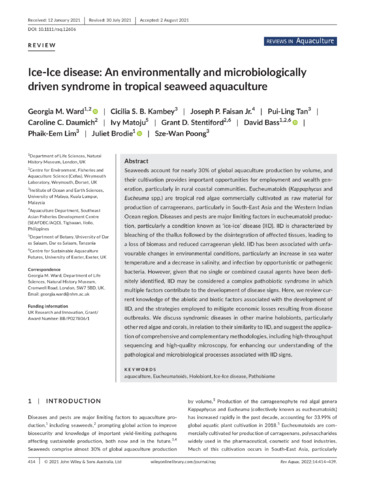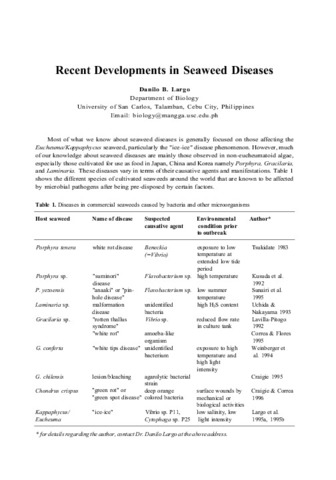Ice-Ice disease: An environmentally and microbiologically driven syndrome in tropical seaweed aquaculture
- Global styles
- MLA
- Vancouver
- Elsevier - Harvard
- APA
- Help

View/
Date
2022-01Author
Page views
3,385ASFA keyword
AGROVOC keyword
Taxonomic term
Metadata
Show full item record
Share
Abstract
Seaweeds account for nearly 30% of global aquaculture production by volume, and their cultivation provides important opportunities for employment and wealth generation, particularly in rural coastal communities. Eucheumatoids (Kappaphycus and Eucheuma spp.) are tropical red algae commercially cultivated as raw material for production of carrageenans, particularly in South-East Asia and the Western Indian Ocean region. Diseases and pests are major limiting factors in eucheumatoid production, particularly a condition known as ‘ice-ice’ disease (IID). IID is characterized by bleaching of the thallus followed by the disintegration of affected tissues, leading to a loss of biomass and reduced carrageenan yield. IID has been associated with unfavourable changes in environmental conditions, particularly an increase in sea water temperature and a decrease in salinity, and infection by opportunistic or pathogenic bacteria. However, given that no single or combined causal agents have been definitely identified, IID may be considered a complex pathobiotic syndrome in which multiple factors contribute to the development of disease signs. Here, we review current knowledge of the abiotic and biotic factors associated with the development of IID, and the strategies employed to mitigate economic losses resulting from disease outbreaks. We discuss syndromic diseases in other marine holobionts, particularly other red algae and corals, in relation to their similarity to IID, and suggest the application of comprehensive and complementary methodologies, including high-throughput sequencing and high-quality microscopy, for enhancing our understanding of the pathological and microbiological processes associated with IID signs.
Suggested Citation
Ward, G., Kambey, C., Faisan, J. P., Jr., Tan, P. L., Daumich, C., Matoju, I., Stentiford, G., Bass, D., Lim, P. E., Brodie, J., & Poong, S. W. (2022). Ice-Ice disease: An environmentally and microbiologically driven syndrome in tropical seaweed aquaculture. Reviews in Aquaculture , 14(1), 414-439. https://doi.org/10.1111/raq.12606
Type
ArticleISSN
1753-5123; 1753-5131Collections
- Journal Articles [1258]
Related items
Showing items related by title, author, creator and subject.
-
Status of seaweed farming in Region 6
Hablo, Roed Shane T. (Aquaculture Department, Southeast Asian Fisheries Development Center, 2002) -
Growth with Equity in Mindanao (GEM) Program and the seaweed industry
Isidro, Alfredo O. (Aquaculture Department, Southeast Asian Fisheries Development Center, 2002) -
Recent developments in seaweed diseases
Largo, Danilo B. (Aquaculture Department, Southeast Asian Fisheries Development Center, 2002)






